As you write your emails, one of many questions that come to your mind might be 'How should I format my emails?' or 'Is this the correct format for this email?'
There is no single way to format an email perfectly. You can follow guidelines, but in the end, it all comes down to your goals, industry, and recipients.
But, you have to start somewhere.
This guide will help you navigate through different email formats with examples and best practices.
Table of contents
What is an email format?
Email format refers to the structure of your email message from the subject line to the email signature.
An email format will guide you on how to structure your message based on the recipient and tailor it to their needs and preferences. Different emails follow different formats, but the intent remains more or less the same - to deliver the intended message.
With that in mind, let's talk about how different elements help create a good format for your emails.
How to format an email?
Let's discuss five important elements of formatting an email in detail:
1. Write clear email subject lines
The subject line is the first thing that the recipient will see. So, it must be clear and state the intent behind sending a particular email. Here are some ways to write a compelling subject line:
Keep it clear, concise, and within the standard character limit.
Keep the recipient and intent of your email in mind while writing email subject lines.
💡 Related read: How to craft email subject lines to skyrocket open rates?
2. Write greetings based on the recipient.
Always begin your email with a greeting or salutation. It sets the tone of your email. Of course, greeting will differ depending on the email you send and your relationship with the recipient.
For instance, if you are sending a professional email and don't know the recipient that well, it is good to have a format like this:
Hey (Name)
Hello (Name)
Greetings
Dear (Name)
3. Keep email body concise and focused
The email copy should cover why you are writing the email, build up a story, and incite interest and engagement among the recipients. You don't have to be super descriptive and write a long email with unnecessary and irrelevant information, nor do you have to summarize the entire email in one line - balance is the key.
4. Give a descriptive name to the attachments
You might or might not send attachments in your email, and that's okay. But, if you send them, a good practice is to name them properly.
For instance, if you send your resume, instead of naming it as 1.pdf, you should name it as (Your Name)Resume.pdf. It will create a great impression, and the recipient can easily figure out what the pdf is about.
5. Have a clear and visible email CTA
Every email must have a clear purpose, and your email call to action must reflect that.
For example, in a marketing email, an email CTA may look like a button saying 'Learn more,' 'Click to read the blog posts,' etc. But, such buttons are not likely to be there while sending professional emails or emails to your colleagues.
Despite that, it doesn't mean you don't include a call to action. Without it, the recipient won't know what you want them to do.
So, always include a clear call to action in your email and make it visible, so the recipient knows what action to take.
💡 Related read: How to write call-to action to get higher clicks?
6. Always close emails with a proper salutation
Signing off is the last part of your email. This is the part where you include your or your organization's name. You can have fun and be creative while writing your email signature.
For instance, Mailmodo adds a casual phrase and their name in one of the emails.

7 email formats with examples
Here we list down 7 types of email and the best format for each of them:
• Professional email format
Professional emails use a formal tone and are related to a business. For example, a freelancer reaching out to clients during the onboarding process will be a professional email. In today's era, these emails should be personalized and specific to the recipient to make a connection with them.
Here is how to format a professional email:
Write a convincing subject line and personalize it as per the recipient.
Use the right greeting based on how well you know the recipient.
Write the email by introducing who you are and why you are writing to the person. Don't pitch your offer immediately; build a connection with them.
End the email with a clear call to action and a professional email signature.
Here's an example of a good professional email where the sender instantly greets the recipient with their name and keeps the tone friendly and inviting.
Hi Thomas,
I'm John, head of sales for ABC Corporation. I'm interested in connecting with you regarding your account.
I'm excited to share a few promotions with you that are expiring next week. Let me know when would be a good time to connect.
All the best, John
• Welcome email format
Welcome emails are crucial to connecting with your subscribers and nurturing them. Sending a properly formatted welcome email can help increase users' engagements while informing them about your brand.
Here are tips to perfectly format your welcome emails to get higher engagements and build stronger connections:
Keep your subject line concise and distinguishable from other emails. For example, you can write something like, Welcome to the family or You just signed up.
Start your email with a proper greeting. It means you should welcome the subscribers; if you can personalize that greeting, it will be like the cherry on top.
Start your email by thanking users for signing up and giving their valuable time to you.
Introduce your brand and let users know what they signed up for. The kind of emails they can expect, etc.
Since welcome email is a part of the nurturing cycle, the right call to action must be there. You should tell users what action they should take next. For instance, you can add links to your most relevant posts they should read.
End your email with the right salutation. It should reflect professionalism and friendliness.
This welcome email begins with a clear headline and then moves on to thank users and brief them on what they can expect in future emails. Besides, this email aims to nurture and inform leads, so there is more than one CTA.
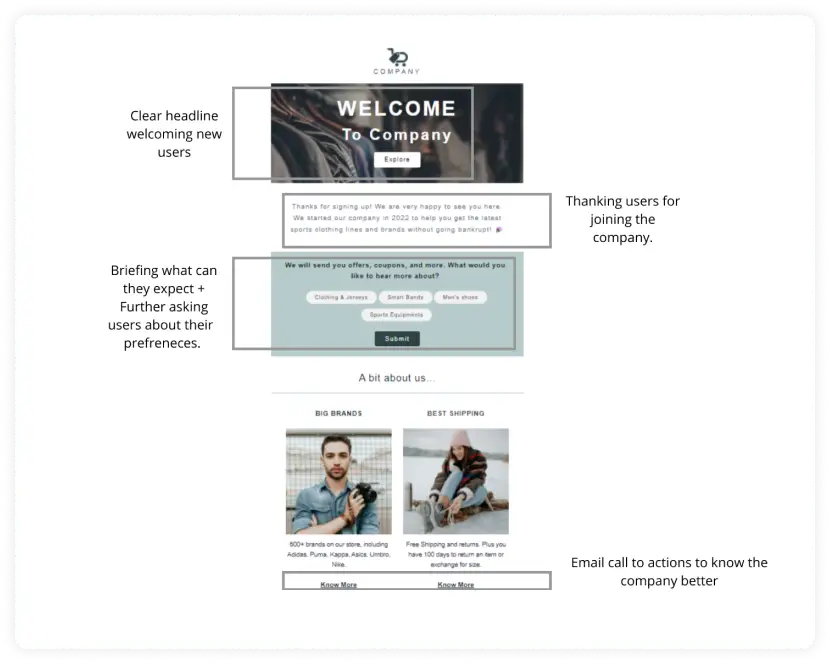
Checkout our more templates for welcome emails
• Promotional email format
Promotional emails are marketing emails that promote a product or services, upcoming events, seasonal sales, etc., to bring more sales. These emails are great for capturing people in a shopping mood, but your emails need to be well formatted.
Here's how to format your promotional emails well:
Make your subject line enticing by citing the offer or making it personalized.
Begin with a proper greeting. You can also personalize using the users' first names to connect better.
Add a compelling headline that highlights your offer. Then you can talk about information to let users know how they can avail the offer. You can also add visual elements like GIFs and Images to make it more engaging.
Always end your promotional emails with a compelling and clear call to action and make email CTA creative rather than generic.
Sign off by adding your brand name, social media links, and relevant information to the users.
Here is a breakdown of the promotional email by Mailmodo.

Checkout out promotional email templates
• Transactional email format
Format for transactional email is more formal as they are sent to update and inform users about their transactions.
For example, it can be about order confirmation, shipping details, signup confirmation, event registration details, etc. Moreover, as these emails are sent to keep users aware, these generally don't have a CTA.
So, these emails follow a standard format like
Greeting users usually with thanking them for their actions.
Briefing them about their transaction, including the respective attachment (link, invoice, etc.), thanking them, and asking them to check their inbox for further updates.
Signing off with your brand's name.
The format for this transactional email begins with greetings in the headline and then briefs users about their transactions. The email also asks users about their feedback, the email CTA.
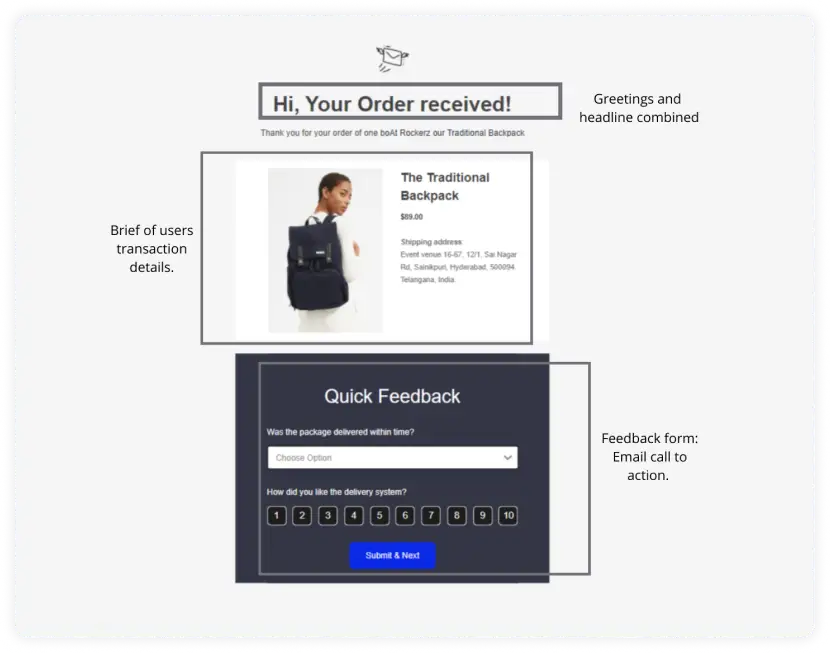
💡 Related read: Transactional emails: use cases, tools, and best practices
• Cold email format
Sending a cold email might be the most difficult email to send. Reaching out to a stranger or someone you admire can seem intimidating, but a properly formatted cold email can do wonders.
So let's look at how to do that:
Since the recipient might get thousands of cold emails, writing a catchy and intriguing subject line will help you stand out from the crowd.
As you don't know the recipient, it is good to stick to professional greetings like Hi/Hello, Dear(name).
Before you write the cold email, we recommend researching the recipient and adding relevant information to understand what you know about them. Some additional things to keep in mind:
Don't start pitching yourself in the beginning. Talk about how you can help them solve their problem or provide value.
Add testimonials and references to build authority and trust. If you don't have any, then leave this part.
Even though you probably include your offer in the email, it is best to include another call to action towards the ending to make it clearer to the recipient.
Again, it is best to stick to the professional email sign-off like Regards, (Your name). But, you can take your time and play with different email closings. For example, you can express gratitude for the recipient's time.
Here is a good example of a cold email format by Mailmodo
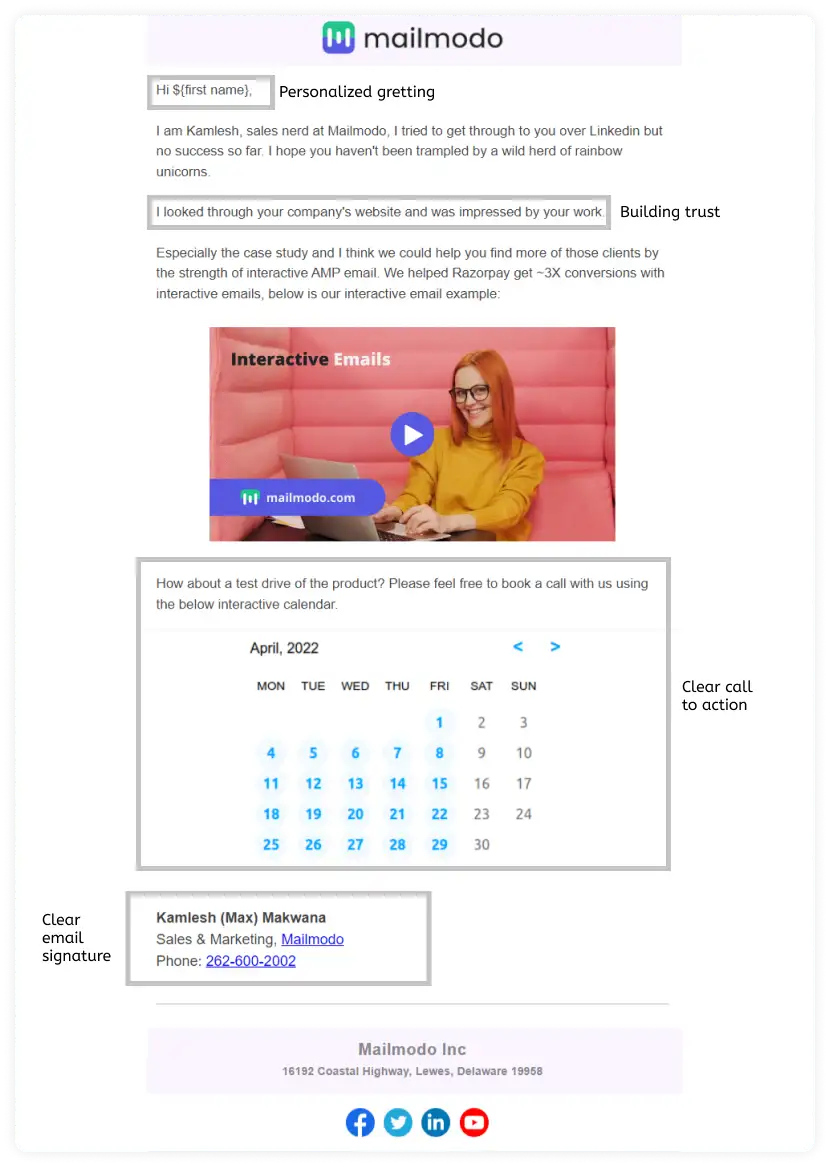
• Newsletter email format
The newsletter comes in all shapes and sizes as informational, includes multiple call-to-action, and has different purposes.
For instance, Marketing brew, Search Engine Journal sends a weekly newsletter summarizing industry news with links to different blog posts, a list of upcoming events, new job postings, and much more.
On the other hand, some newsletters entirely contain the repurposed content from the original post and give you a preview of the original post.
So, there is not a pre-defined format while writing a newsletter. Whatever resonates with your audience and helps you achieve your goals will be perfect.
Here is a breakdown of Mailmodo's bi-weekly newsletter format:
- First comes the headline and greeting, which we keep generic. Then we add a little email and 1st CTA to ask for users' views via a survey that we are currently working on.
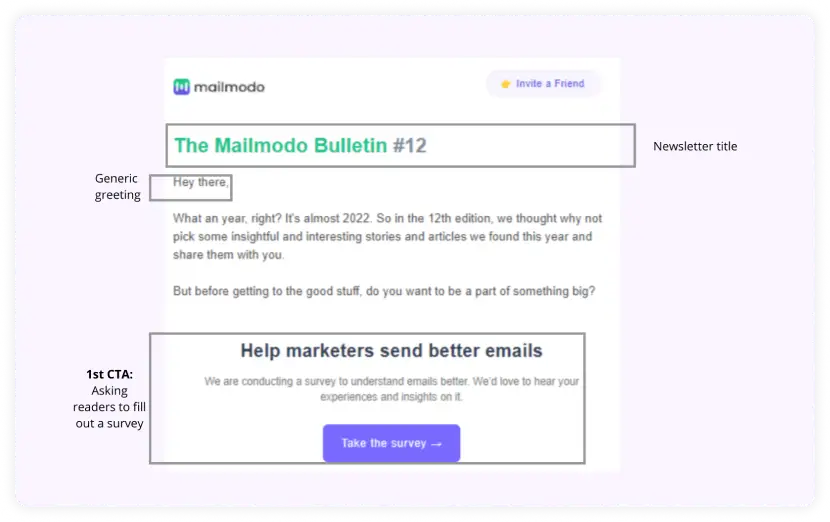
Then we include a list of the best and most relevant articles to inform readers about what is trending in the industry.
Then comes the 2nd CTA, where we add a link to our latest growth chat session. In addition, to dust off the information load, a GIF is added.
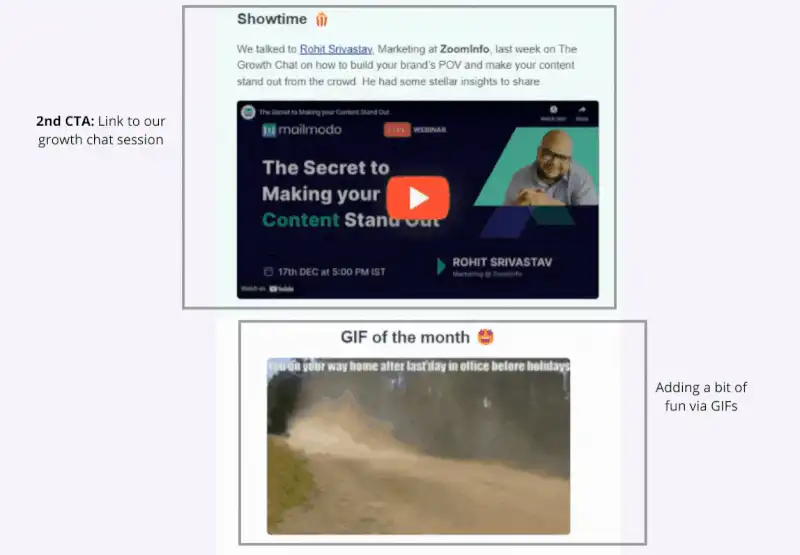
Towards the newsletter end, we include a 3rd CTA. It changes in every edition.
Then, we sign off and, in the end, include a feedback form to get insights into our edition.
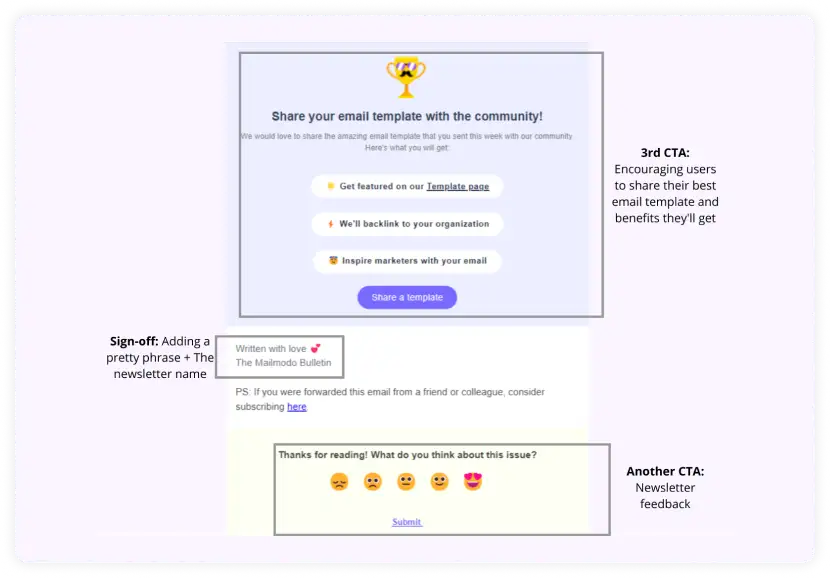
• Follow-up email format
Follow-up email must include a catch-up on earlier emails sent to the recipient to sound relevant and make sense to them.
For instance, if a user checked your product pages but didn't sign up, you can send them an email like -"Hey, we saw that you checked out our products. Did feeling stick somewhere? We can help!"
The email below begins with thanking users and greeting users with their names. After that comes the email copy and the CTA - the feedback form.
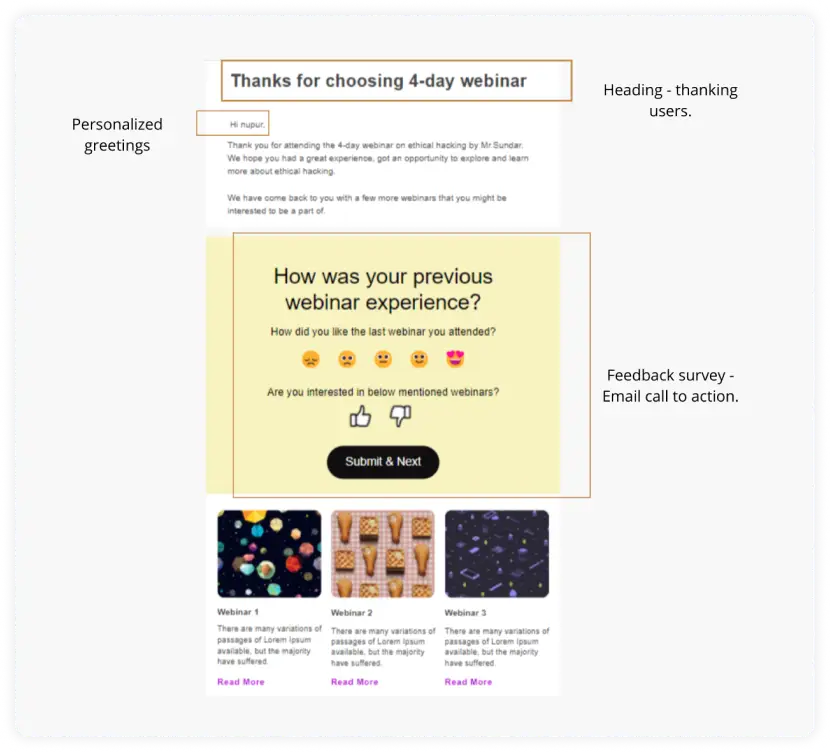
Checkout our more templates for a follow-up email
Email format best practices
While you are deciding on how to format your email marketing campaigns, ensure that you follow these best practices to get the desired results:
Use a clear and easy-to-understand email address. The name and domain name should be clear and clearly indicate the email's sender.
Follow all the email etiquettes such as greetings, how to close, etc.
Use tone and style that will resonate most with the recipient.
Keep your target recipient and the intent of your emails at the core while writing the email.
Always preview your emails for typos and other errors before sending them.
Personalize your email wherever possible - subject line, greetings, email copy, email call to action, etc.
Make your email responsive for different devices.
A/B tests different formats to decide which works best and generates desired results.
Takeaway
Formatting an email follows the same structure as writing a letter - you acknowledge the reader, put your thoughts forward, and end with a clear call to action. When you format an email properly, you gain readers' attention, encourage them to take action, and let them know how to connect with you.
But, you don't have to always abide by the best email formats. If you think you can make your email more appealing and engaging to the reader by trying out a different approach, then why not?
If you are looking for a tried-and-tested, industry-approved email format, you can always look at our library of 200+ email templates.
What you should do next
Hey there, thanks for reading till the end. Here are 3 ways we can help you grow your business:
Talk to an email expert. Need someone to take your email marketing to the next level? Mailmodo’s experts are here for you. Schedule a 30-minute email consultation. Don’t worry, it’s on the house. Book a meet here.
Send emails that bring higher conversions. Mailmodo is an ESP that helps you to create and send app-like interactive emails with forms, carts, calendars, games, and other widgets for higher conversions. Get started for free.
Get smarter with our email resources. Explore all our knowledge base here and learn about email marketing, marketing strategies, best practices, growth hacks, case studies, templates, and more. Access guides here.


